NOTES
Saturday, July 7, 2007
06:50
White, still, quiet and wet
Birds Sighted in Order of Arrival:
1. mwlblb (Tame Bird)
2. unbanded juvenile
3. unbanded juvenile
4. banded juvenile
5. mrgo (Mr. Go)
6. unbanded adult (Shopper)
7. mlbob (Mrs. Go)
8. mwrg (Wringer
9. lbpmp (Princesa)
10. mlbrg (Trapper)
11. unbanded (Rusty Bill)
12. mwbw (Checkers)
13. mgrr (Droopy)
Notes:
Shopper is especially aggressive this morning. He is chasing one of the baby jays, here to practice opening peanuts. He swoops fast, through the feeding area, between tree branches reminding me of a bully on the playground. His ratty tail feathers give him an undignified look as he flies. If there were to be a male take-over at this feeder, I bet he would win the contest. He is unlike the others, who show patience and understanding for the young birds. He makes a loud “chooka, chooka, chooka, chook,” temporarily displacing all the birds. Crest plastered back, he crouches low like a jaunty-capped road racer, focused on making good time.
The jays have paths by which they navigate through the trees, branch by branch. They hop and glide through the familiar territory with speed and agility, landing solidly, on spindly legs that belie their strength. They make sharp, familiar turns through networks of leaves. Negotiating openings, they weave their way through levels of space the way we negotiate a river crossing, hopping, then wading, from stone to stone.
Maybe because it’s wet and dewy this morning, the tail feathers of all the birds appear worn and frayed. Molting is progressing at a rapid rate, the new row of feathers, visible beneath the wings when the birds dip their heads down, inches its way posteriorly. I wonder at what point will these new feathers replace the old? I’m saving the loose feathers I find on the ground, a permanent record of the season.
Two juveniles land on the bench, face off, and beg, bill-to-bill. Mr. Go lands; one juvie flies off, and the other begs to the adult male. This is the second time I’ve seen this behavior. It leads me suspect the two are siblings, and possible offspring of Mr. and Mrs. Go.
Again outnumbered by males, the females this morning include plbmp, mlbob, and mgrr. Pia told me yesterday it takes about 16 days for eggs to incubate and 16-20 days for the young to fledge, which means the nesting females could be missing from the feeder for well over a month. She described how the young birds gradually fill the nest until they are too big to fit any longer. They begin flapping their wings and move out onto branches. It is during this period that the fledglings are most exposed and most vulnerable to predators. One pair of adults lost all four of its progeny to ravens at this stage of development; after which, they were forced to begin again, repeating the process of mating, egg-laying, nesting, and feeding their young.
White, still, quiet and wet
Birds Sighted in Order of Arrival:
1. mwlblb (Tame Bird)
2. unbanded juvenile
3. unbanded juvenile
4. banded juvenile
5. mrgo (Mr. Go)
6. unbanded adult (Shopper)
7. mlbob (Mrs. Go)
8. mwrg (Wringer
9. lbpmp (Princesa)
10. mlbrg (Trapper)
11. unbanded (Rusty Bill)
12. mwbw (Checkers)
13. mgrr (Droopy)
Notes:
Shopper is especially aggressive this morning. He is chasing one of the baby jays, here to practice opening peanuts. He swoops fast, through the feeding area, between tree branches reminding me of a bully on the playground. His ratty tail feathers give him an undignified look as he flies. If there were to be a male take-over at this feeder, I bet he would win the contest. He is unlike the others, who show patience and understanding for the young birds. He makes a loud “chooka, chooka, chooka, chook,” temporarily displacing all the birds. Crest plastered back, he crouches low like a jaunty-capped road racer, focused on making good time.
The jays have paths by which they navigate through the trees, branch by branch. They hop and glide through the familiar territory with speed and agility, landing solidly, on spindly legs that belie their strength. They make sharp, familiar turns through networks of leaves. Negotiating openings, they weave their way through levels of space the way we negotiate a river crossing, hopping, then wading, from stone to stone.
Maybe because it’s wet and dewy this morning, the tail feathers of all the birds appear worn and frayed. Molting is progressing at a rapid rate, the new row of feathers, visible beneath the wings when the birds dip their heads down, inches its way posteriorly. I wonder at what point will these new feathers replace the old? I’m saving the loose feathers I find on the ground, a permanent record of the season.
Two juveniles land on the bench, face off, and beg, bill-to-bill. Mr. Go lands; one juvie flies off, and the other begs to the adult male. This is the second time I’ve seen this behavior. It leads me suspect the two are siblings, and possible offspring of Mr. and Mrs. Go.
Again outnumbered by males, the females this morning include plbmp, mlbob, and mgrr. Pia told me yesterday it takes about 16 days for eggs to incubate and 16-20 days for the young to fledge, which means the nesting females could be missing from the feeder for well over a month. She described how the young birds gradually fill the nest until they are too big to fit any longer. They begin flapping their wings and move out onto branches. It is during this period that the fledglings are most exposed and most vulnerable to predators. One pair of adults lost all four of its progeny to ravens at this stage of development; after which, they were forced to begin again, repeating the process of mating, egg-laying, nesting, and feeding their young.
Subscribe to:
Post Comments (Atom)
Pia Sets the Trap
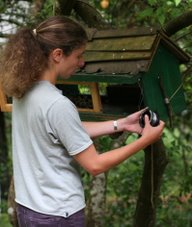
07/24/07
Peaking...
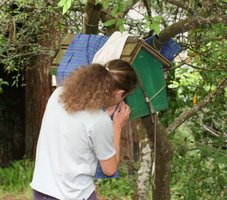
07/24/07
Oops, wrong bird!
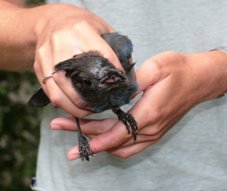
Demonstrating the "hold"
Try Again
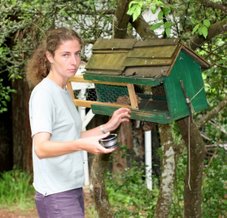
Bird in the Bag
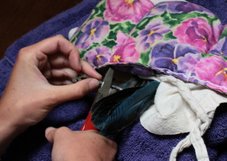
Applying a metal band
Measuring
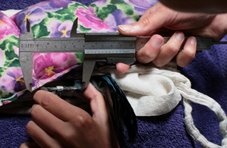
and more measuring. . . .
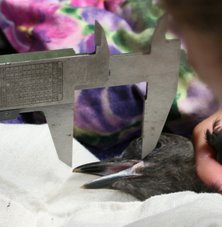
Blood Sampling
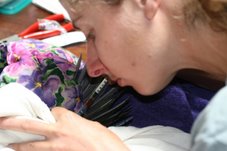
Jeff J's Work
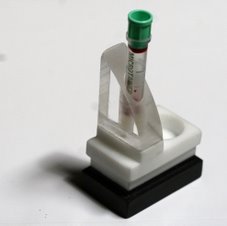
Pia's test tube holder
Weighing
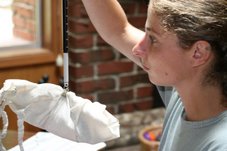
And then....release
When the sun goes down...
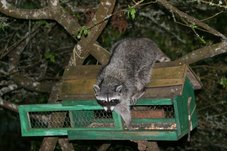
Steller's Jay Taxonomy/Description
Common Name: Steller's Jay
Class: Aves
Order: Passeriformes
Family: Corvidae
Genus: Cyanocitta
Species: Cyanocitta stelleri
Steller’s jay belongs to the family, Corvidae, in the Avian Order Passeriformes. Passeriformes is the order of perching birds. Corvidae is the jay, magpie and crow family. The Steller's jay's scientific name is Cyanocitta stelleri. The generic name, cyanocitta, means "blue jay". Its specific name, stelleri, named for George W. Steller (1709-1746). Steller was a German zoologist who explored the coastal areas of the northern Pacific Ocean in 1740.
Band Colors
black | white | purple | red | orangeBands are read in the following order:
light blue and light blue | green
Note: Light blue is difficult to read. It darkens with age, resembling a green band. (b/w/p/r/o/lb/g)
right bottom band
right top band
left bottom band
left top band
Data Collecting
This information was copied from the website of Dr. Jeff Black, Humboldt State University Wildlife Department.
The data to include for each record:
- Bird’s color code
- Size of social group seen at the same time
- Associates’ color codes (or if unbanded = UNB; or not determined = NOTD)
- Number of times associates came within 3 meters of each other
- Approximate time spent within 3 meter distance (e.g. 2 seconds, 15 sec, etc.)
- Total time you watched the birds (e.g. 5 minutes, 10 min, etc.)
- Time of day; start of observation (e.g. 1935)
- Date (e.g. 9.30.99)
- Location of observation (e.g. Rewood Bowl SW corner west bleachers. And state whether the bird was seen at a birdfeeder or in trees, etc)
- Comments (e.g. deformed leg, feather tuft on back, etc.)
Arcata Steller's Jay Sightings
Mr. Go
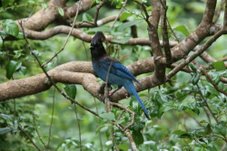
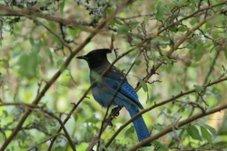
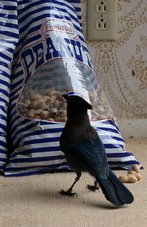
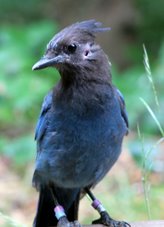
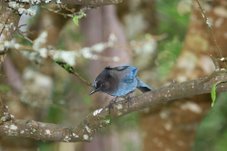
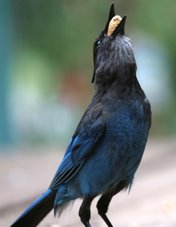
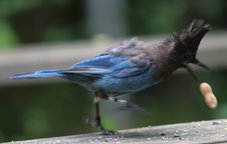
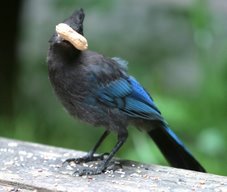
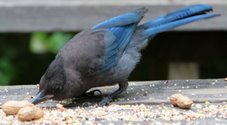
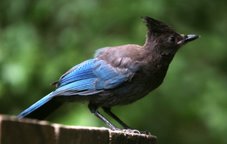
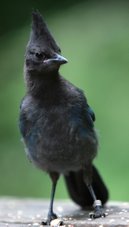

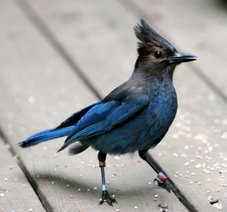
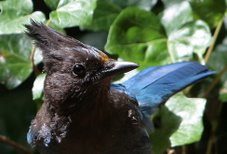
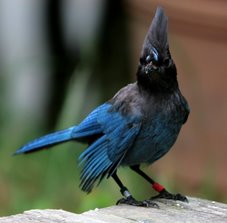
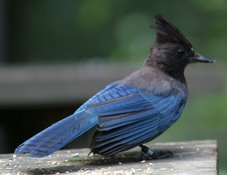
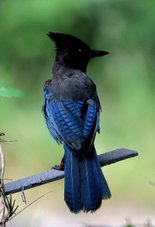
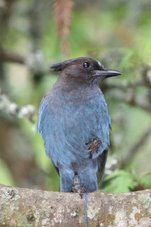
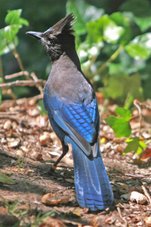
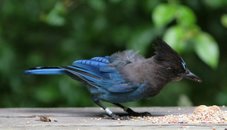
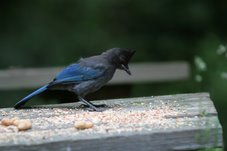
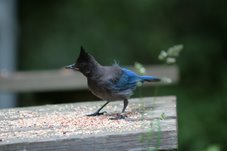
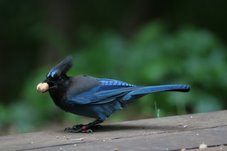
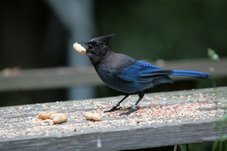
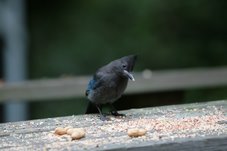
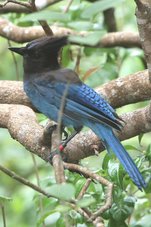
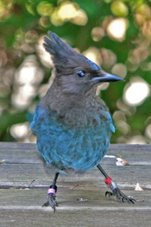
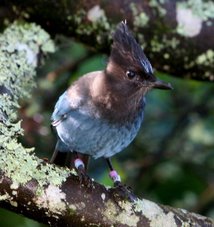
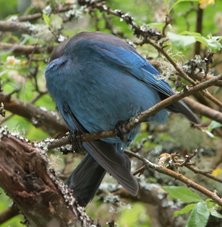
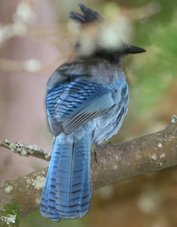
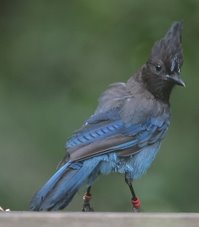
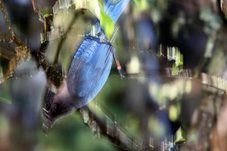
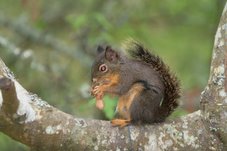
1 comment:
I appreciate the fact that you've named the birds. It makes it earsier to construct a story from your observations. This preference on my part may not be scientific, but that's the kind of reader I am.
I think that may be one thing that made Jane Goodall's work popular and accessible: she named the chimps she observed in the wild. It does raise the question of how much our observations are projected, but your descriptions are wonderful and I'm learning a lot about birds and bird behavior. Great job Catherine!
Post a Comment